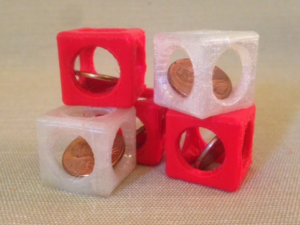 All across the 3D printing industry, companies are launching objectives and initiatives aimed at educating the next generation of the workforce on the technology. 3D printing is an important and powerful tool in STEAM education, which includes the arts in the forward-thinking focus of science, technology, engineering, and mathematics, and including 3D printing in STEAM lesson plans can teach kids real world skills.
All across the 3D printing industry, companies are launching objectives and initiatives aimed at educating the next generation of the workforce on the technology. 3D printing is an important and powerful tool in STEAM education, which includes the arts in the forward-thinking focus of science, technology, engineering, and mathematics, and including 3D printing in STEAM lesson plans can teach kids real world skills.
In the summer of 2016, desktop 3D printer manufacturer Ultimaker launched an educational initiative of its own with the Pioneer Program, which invites educators to share their own 3D printing work and experiences on the Ultimaker Education website. Contributors maintain ownership of any submitted content through Creative Commons Attribution, Share-Alike, and Non-Commercial licensing, and there are now more than 100 global members, or pioneers, who are sharing their content, curriculum, lessons, projects, and best practices through the program.
Not long after the program launch, Ultimaker announced education challenges in multiple countries, including the Asia-Pacific region, and it’s also a co-founding sponsor of Construct3D 2018, the national academic 3D printing and digital fabrication conference and expo set to take place at Georgia Tech this October.
Now, following the company’s recent news that it has further committed to education in North America by joining the GE Additive Education Program (AEP) as a sponsor and supplier, Ultimaker announced the launch this week of its new Ultimaker Core Lessons: STEAM Set for educators.
The set includes eight free lessons, based on guidance and feedback from the company’s North American partners and educators, that can help teachers in informal, K12, or Higher Ed classrooms incorporate 3D printing into their education practices and STEAM curriculum.
- Lesson 1: Coin Traps
- Lesson 3: Flashlight
“As teachers, we want learning environments and activities that engage and challenge our students. We want to tap into their curiosity, inspire them to see connections between ideas and information and have them use their understanding to creatively problem solve with independence,” said Ultimaker Education Community Strategist Liz Arum. “Our objective is to instill a love of learning, so that they can think critically, communicate effectively, persevere, be intrinsically motivated, be responsible for their own learning outcomes, and find joy in the process.”
The set of eight lessons, published under a Creative Commons Attribution-ShareAlike 4.0 International License and immediately available for distribution and classroom use across North America, joins many other educational 3D printing resources and projects on the company’s Pioneer Education pages, and can inspire Ultimaker educators to come up with new ideas and experiences for the classroom.
The recommended participant age range is 10+ for these beginner lessons, which are:
- Lesson 1: Coin Traps
- Lesson 2: Pill Box
- Lesson 3: Flashlight
- Lesson 4: Potato Head Challenge
- Lesson 5: Sphericons
- Lesson 6: Creative Type
- Lesson 7: Penny Whistles
- Lesson 8: Tessellations
Students will learn all sorts of skills in these lessons, including how to align objects and create the same model in multiple applications, how to execute boolean operations and modify a print job with Cura plugins, a more thorough understanding of geometry, using symbols to communicate ideas, and how to effectively work together on creative projects.
When teachers integrate 3D printing into the classroom with the Ultimaker Core Lessons: STEAM Set, they can meet all sorts of important educational objectives, like building cooperative learning opportunities and helping students further develop their communication skills through constant sharing and documentation. Teachers can also encourage and support their students’ personal learning objective explorations, build up resiliency by using rapid prototyping and testing techniques, and give students important learning aids, such as Design Thinking methods.
Discuss 3D printing in the classroom, and other 3D printing topics, at 3DPrintBoard.com or share your thoughts in the Facebook comments below.
[Source/Images: Ultimaker]
Subscribe to Our Email Newsletter
Stay up-to-date on all the latest news from the 3D printing industry and receive information and offers from third party vendors.
You May Also Like
Insights from Cantor Fitzgerald on AM’s Q1 2024 Landscape
A recent survey by Cantor Fitzgerald sheds light on the persistent challenges within the additive manufacturing (AM) industry in the first quarter of 2024. Based on responses from 38 industry...
3D Printing Financials: voxeljet’s NASDAQ Exit and Final US Stock Earnings Report
In an anticipated move, voxeljet has transitioned from the Nasdaq to the Over-The-Counter (OTC) market amid the challenges reflected in its stock performance and the broader financial landscape. Furthermore, the...
Seurat CFO Di Paola Shares Insights on Defying Industry Trends in 3D Printing
In an industry where 3D printing public companies are grappling with troubled earnings and workforce reductions, Seurat is defying market trends by increasing its workforce sevenfold, growing from 20 to...
Printing Money Episode 16: Q4 Earnings Analysis with Troy Jensen, Cantor Fitzgerald
The Q4 earnings season is a wrap, and to put a bow on it here is Episode 16 of Printing Money, with Troy Jensen (Cantor Fitzgerald) returning to join Danny...





































